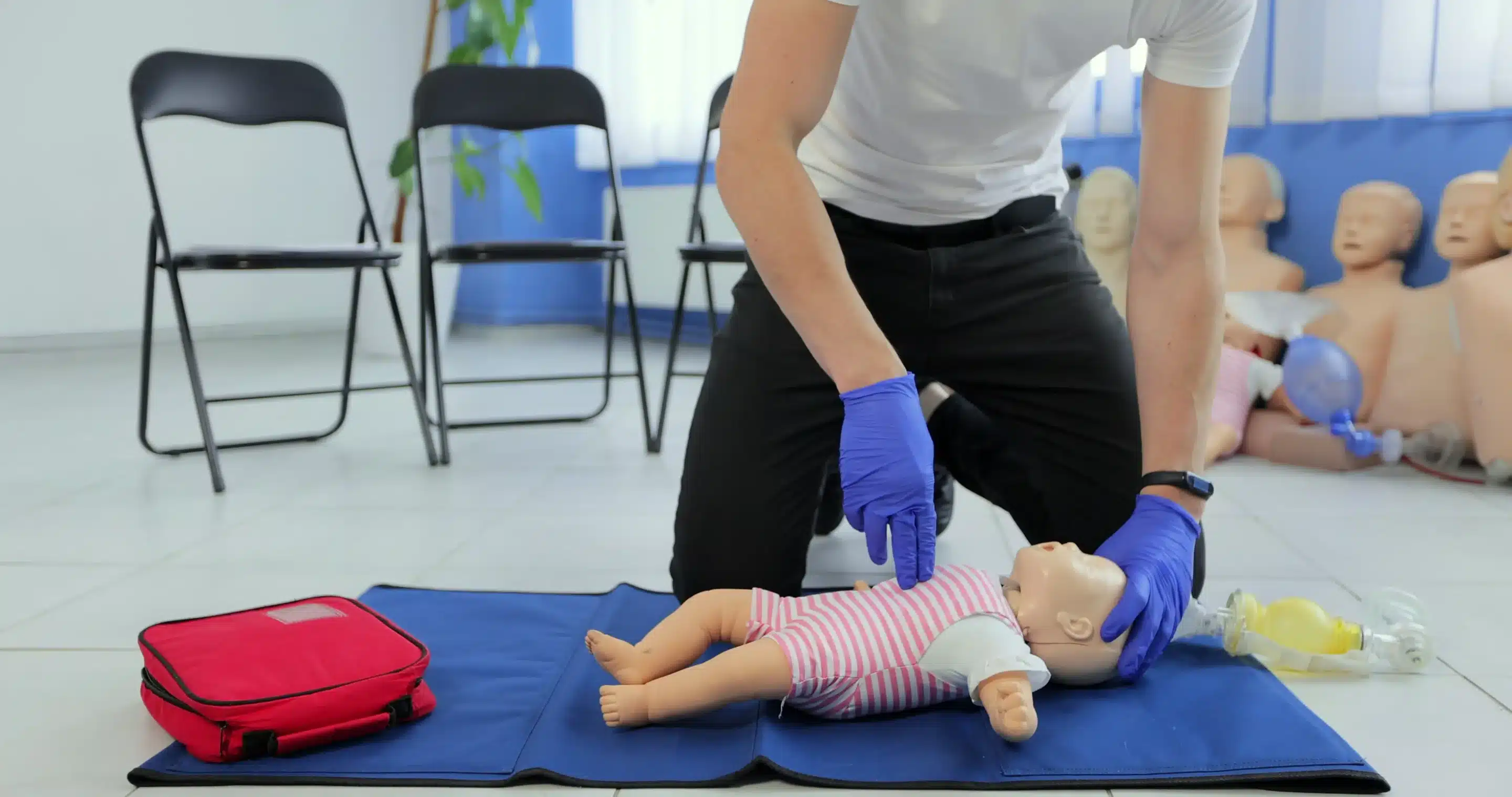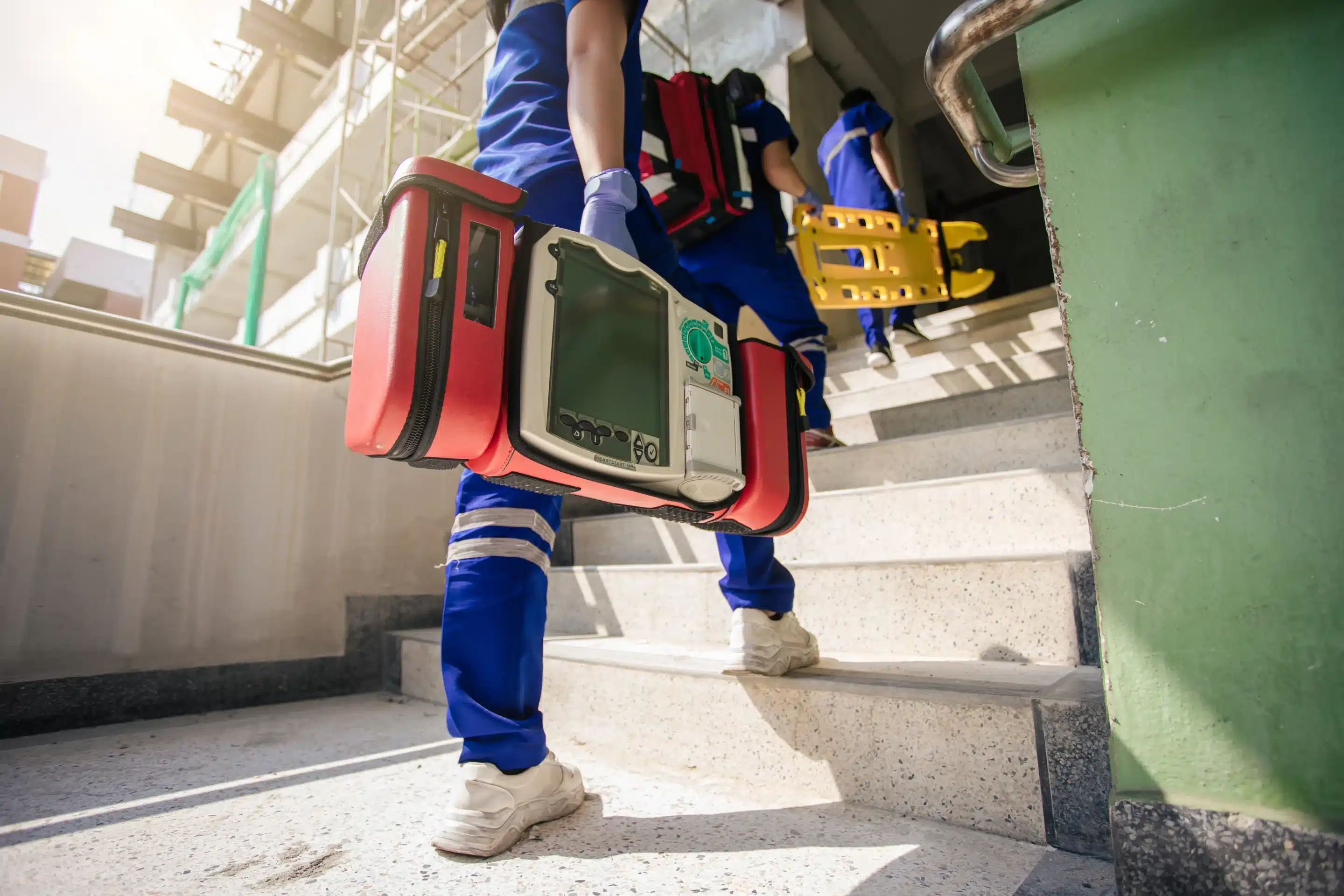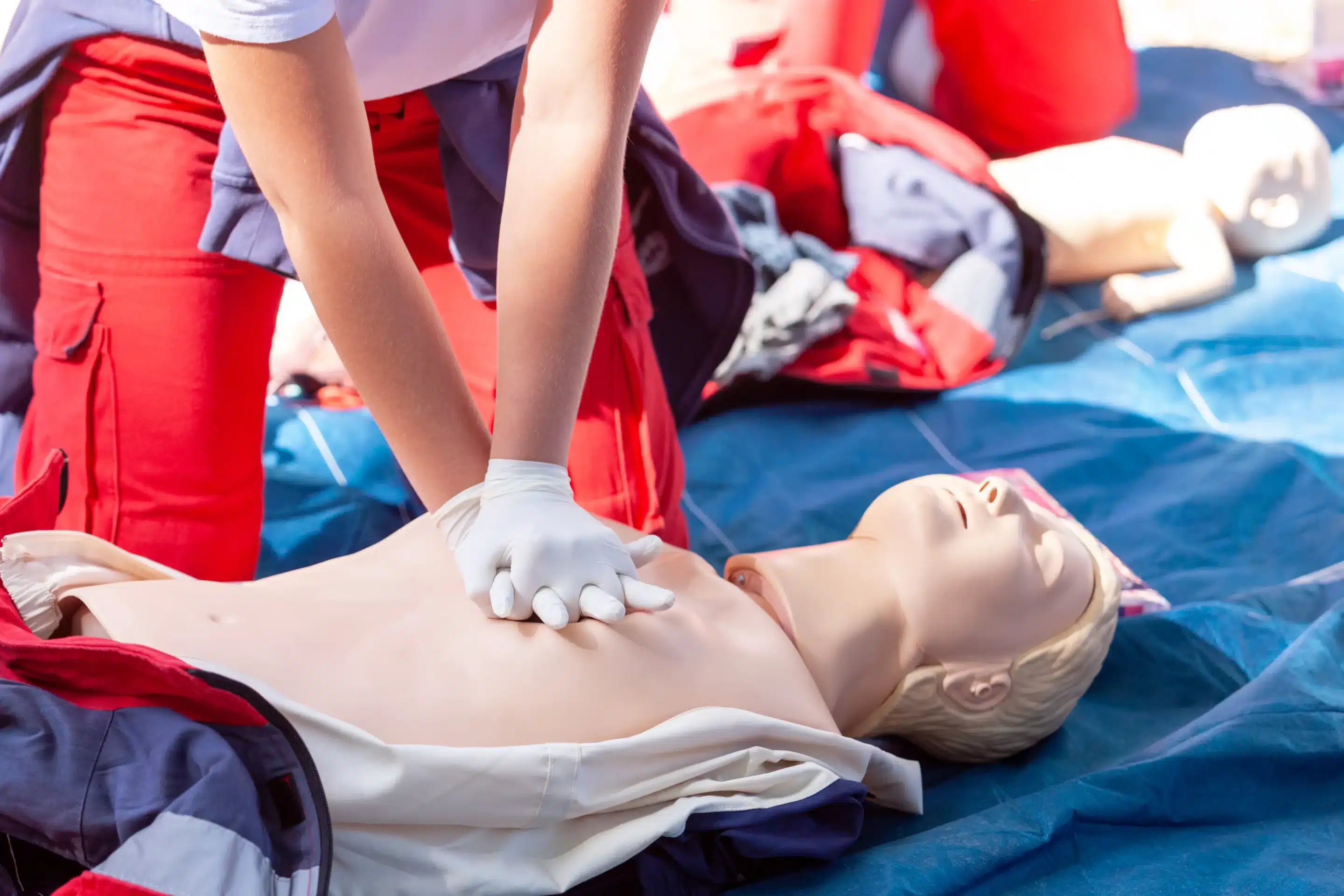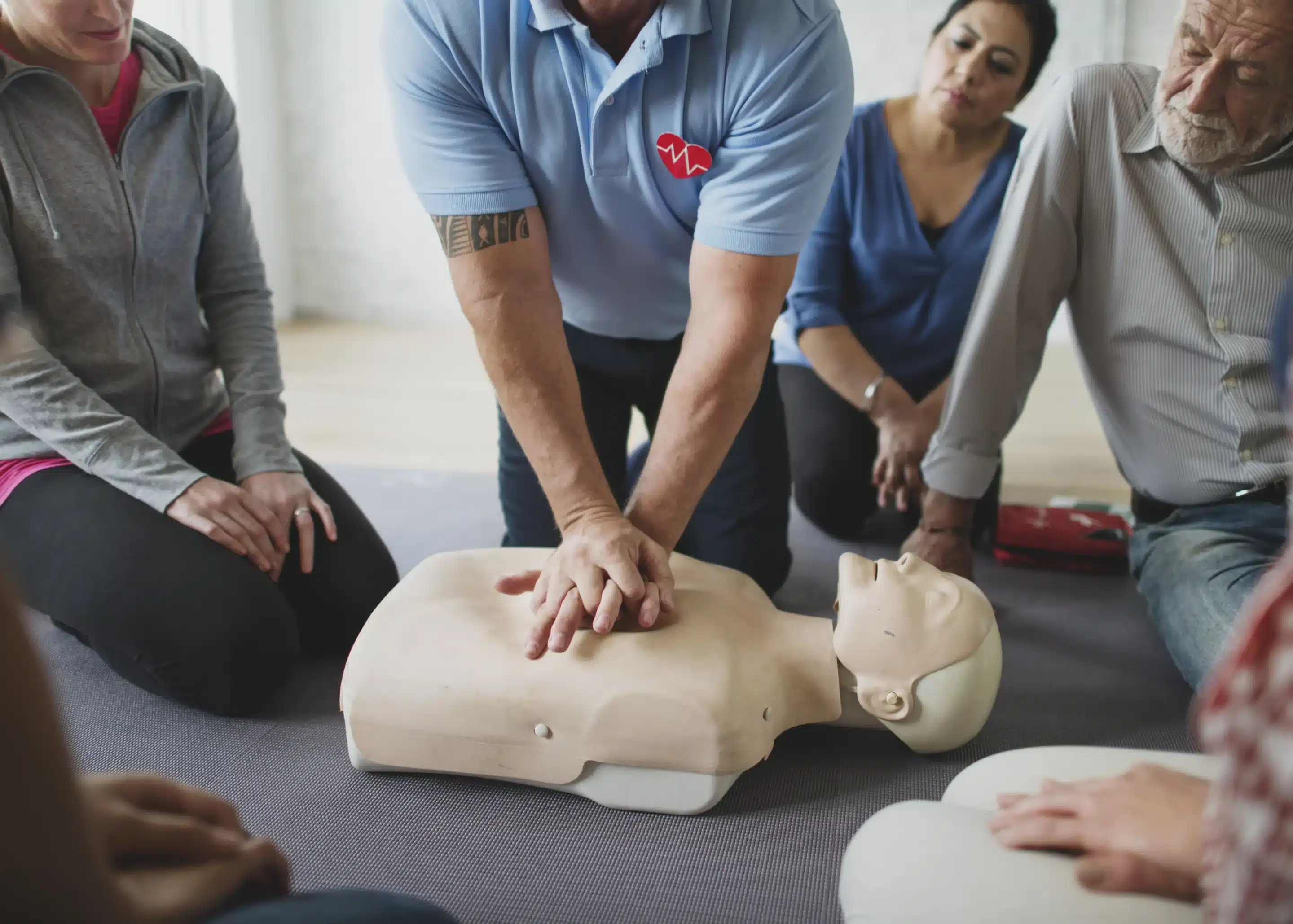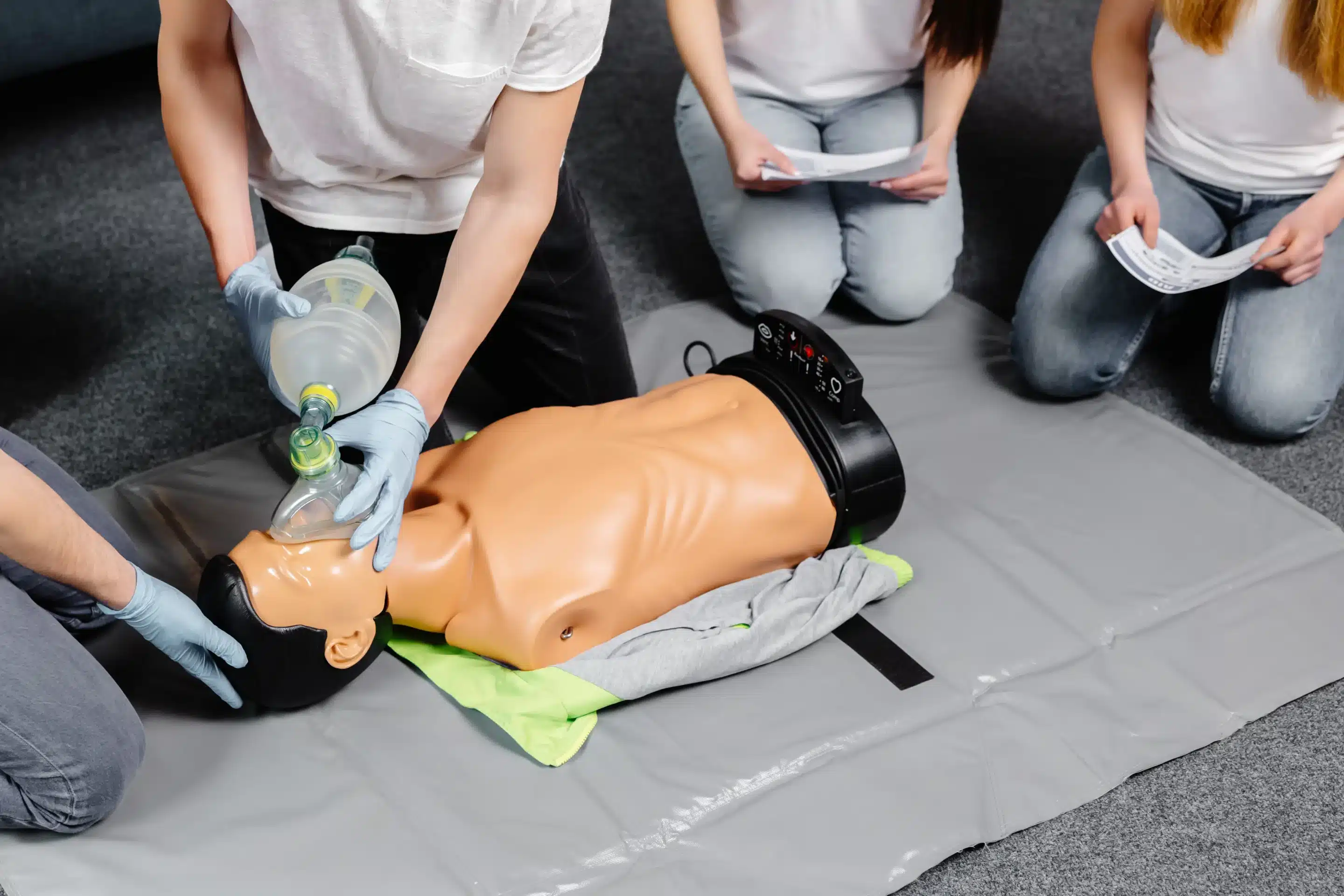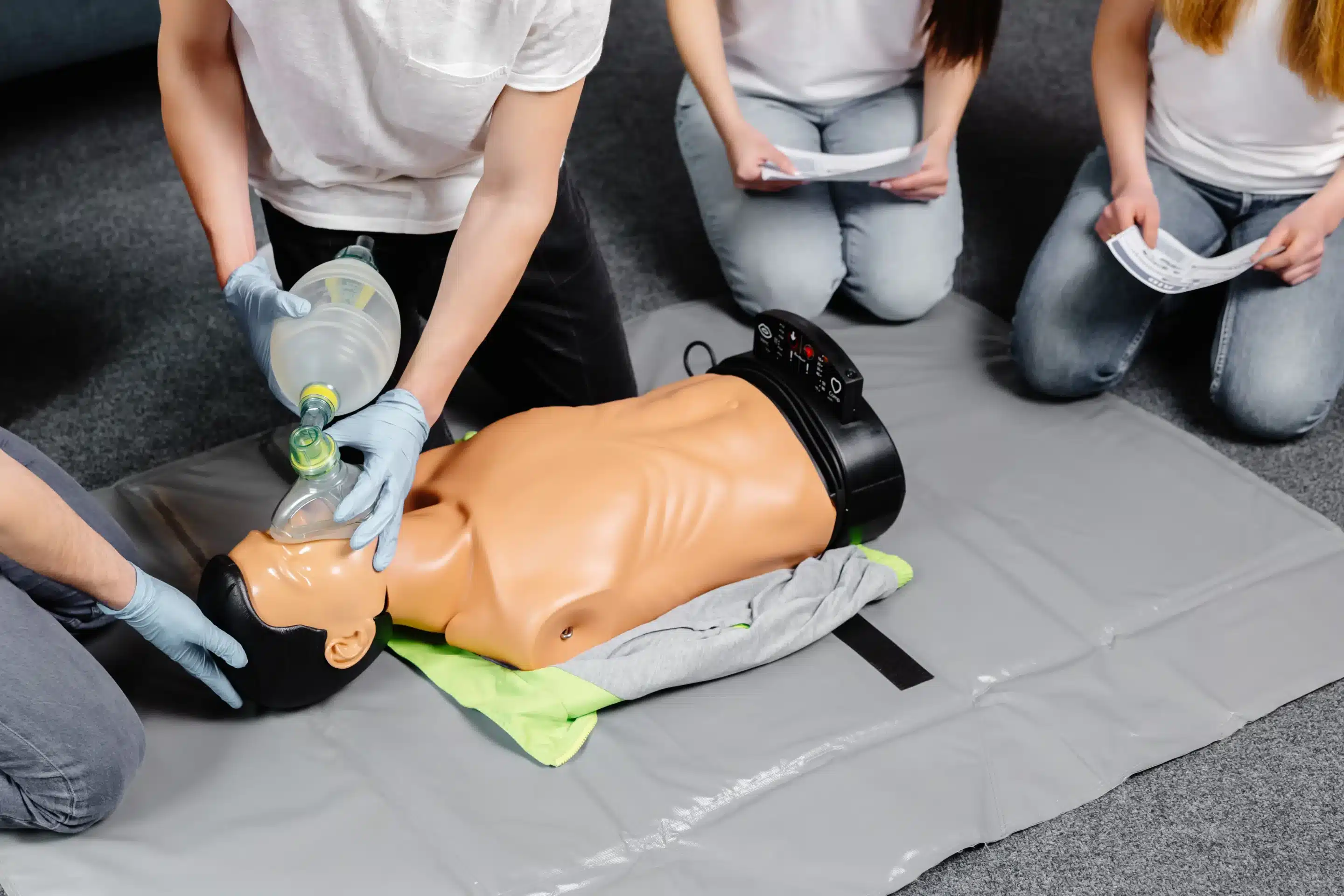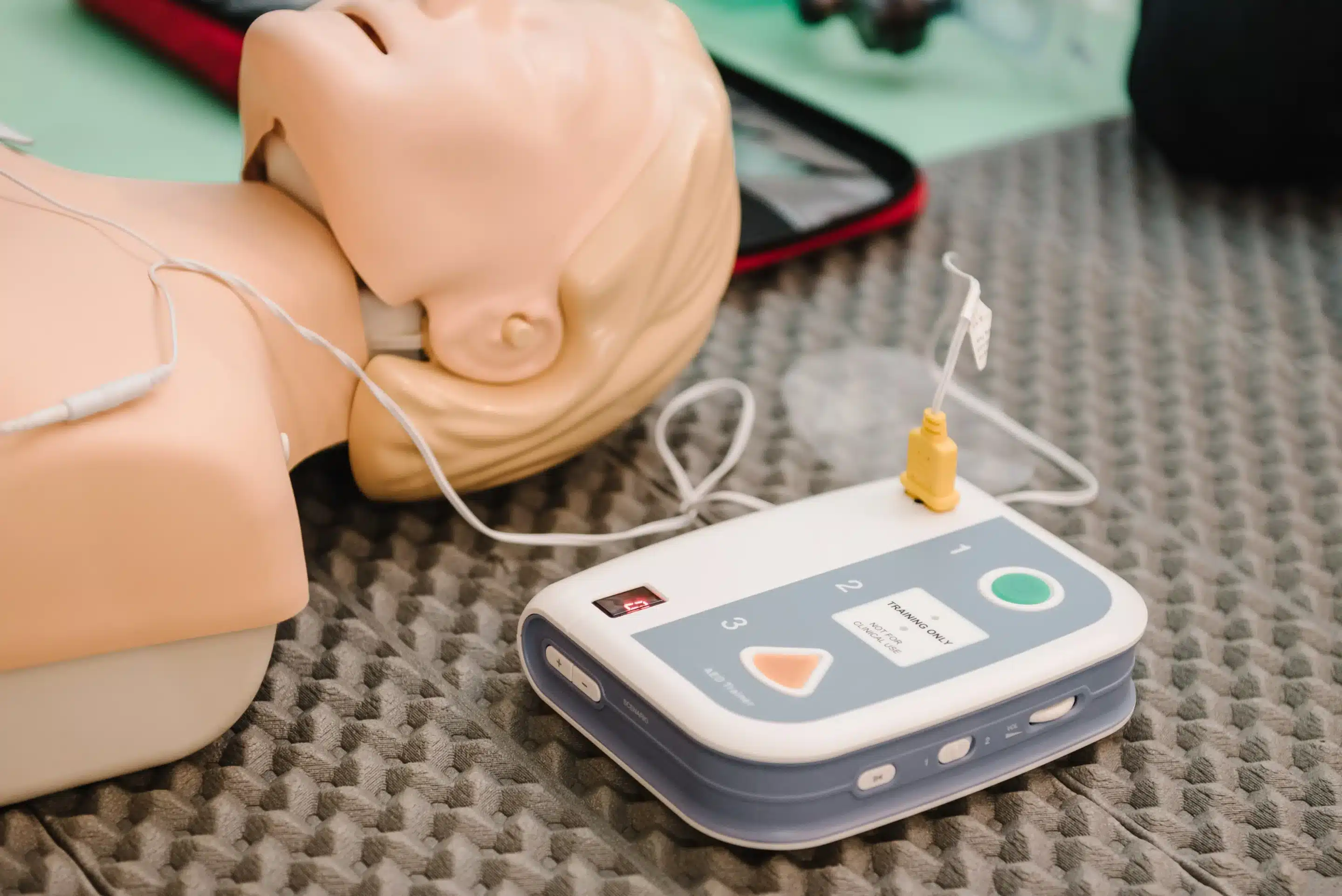In a medical emergency, seconds can matter. CPR can be the difference between life and death, doubling or even tripling a person’s chance of survival. This guide is your resource for understanding the importance of CPR and finding the right training for you. We’ll cover the various types of CPR courses available, how to locate CPR courses near me, what to expect during training, and how to maintain your skills. We’ll also discuss certification, renewal, and the different learning formats, including in-person, online, and hybrid options.
Key Takeaways
- CPR skills are essential for everyone: From basic life support to advanced cardiac care, CPR training empowers you to respond effectively during medical emergencies. Find a course that aligns with your individual needs and professional goals.
- Choose a reputable training provider: Seek out programs accredited by nationally recognized organizations like the American Heart Association. Consider course format, instructor experience, and reviews when selecting your training.
- Stay current with your CPR certification: Regular practice and refresher courses are vital for maintaining your skills and staying up-to-date with the latest guidelines. Explore advanced certifications to expand your knowledge and enhance your life-saving capabilities.
What are CPR Courses & Why are they Important?
CPR courses teach you how to respond to cardiac emergencies. From recognizing the signs of a heart attack to performing chest compressions and giving rescue breaths, these courses empower you to act quickly and confidently in a crisis. The training often includes how to use an Automated External Defibrillator (AED), another important tool for saving lives.
Learn Life-Saving Skills
CPR courses offer hands-on training in essential, life-saving techniques. You’ll learn to assess an emergency, perform chest compressions, give rescue breaths, and use an AED. These skills can dramatically improve the outcome of a cardiac emergency. Organizations like the American Red Cross offer a range of CPR/AED classes to help people develop these critical skills.
Improve Emergency Survival Rates
Learning CPR can significantly increase survival rates during cardiac emergencies. With nearly half a million Americans dying from sudden cardiac arrest every year, knowing CPR can be the difference between life and death. It can double or even triple a person’s chance of survival. Becoming CPR-certified makes you a vital link in the chain of survival, able to provide immediate assistance while waiting for paramedics or other medical professionals.
CPR Course Options Near You
Finding the right CPR course can feel overwhelming with so many options. This section breaks down the different types of CPR training available in Bakersfield, helping you choose the best fit.
Basic CPR for Everyone
Whether you’re a parent, teacher, or simply someone who wants to be prepared, a basic CPR course is a great place to start. These courses cover the essentials of CPR and often include AED training. Bakersfield offers a wide range of CPR training options, from basic to advanced certifications. Finding the right CPR course for your needs, whether personal or professional, is easier than you think. Basic CPR certification is a valuable skill that can empower you to save a life.
CPR for Healthcare Professionals
Healthcare providers, including doctors, nurses, and EMTs, require more advanced CPR training. Bakersfield CPR Classes offers a comprehensive range of American Heart Association (AHA) courses, including BLS, ACLS, and PALS. These courses cover advanced life support techniques tailored to the demands of a healthcare setting.
Pediatric CPR & First Aid
If you work with children, Pediatric CPR and First Aid courses are essential. These courses focus on the unique needs of infants and children. They are crucial for childcare providers, teachers, parents, and anyone regularly interacting with kids. EMSA Child Care Health & Safety training and RQI programs are also available for healthcare professionals in Bakersfield.
Specialized CPR Training
Beyond the basics, specialized CPR courses are designed for specific industries and situations. These might include wilderness first aid, lifeguard training, or advanced cardiac life support. Advanced training and specialized courses often require a more significant time commitment to ensure comprehensive coverage of essential skills. Consider your specific needs and explore the advanced options available.
Find Reputable CPR Training
Finding the right CPR training program is crucial for learning effective, life-saving skills. Here’s how to find reputable CPR training near you:
Check Certifications & Affiliations
Look for training providers accredited by nationally recognized organizations like the American Heart Association (AHA). This ensures the program meets established standards and covers the latest guidelines. Bakersfield CPR Classes offers a range of AHA-certified courses, including BLS, ACLS, PALS, and more. Certification from a reputable organization adds credibility to your training and ensures you receive high-quality instruction. Ready Response PA emphasizes the importance of accreditation when choosing a CPR training provider to guarantee employees receive relevant and effective training.
Explore Reviews & Testimonials
Reading reviews and testimonials from past participants offers valuable insights into a program’s quality. Look for comments about the instructors, course materials, and overall learning experience. Positive feedback can give you confidence in your choice of training provider. Juniper Safety offers a comprehensive guide on choosing the right CPR training program.
Use Online Resources
Online resources can be incredibly helpful in your search for CPR training. Websites like CPR Certification Now offer valuable information on CPR techniques and the importance of refresher courses. You can also find instructional CPR videos online to supplement your learning and keep your skills sharp. Many training providers also have websites with detailed course information, schedules, and registration options.
What Happens in a CPR Course?
CPR courses equip you with the knowledge and skills to respond effectively in a medical emergency. Whether you’re taking a basic CPR class or pursuing advanced certification like ACLS, you’ll learn essential life-saving techniques. Here’s what you can expect during your training:
Course Content & Skills
CPR courses cover a range of topics, starting with recognizing the signs of a cardiac arrest or breathing emergency. You’ll learn how to assess a situation quickly and safely. The curriculum includes instruction on performing chest compressions, delivering rescue breaths, and using an automated external defibrillator (AED). Many courses also incorporate training on choking relief and basic first aid. Bakersfield CPR Classes offers a variety of American Heart Association (AHA) courses, ensuring your training aligns with the latest guidelines.
Hands-On Practice & Assessment
CPR training isn’t just about lectures and videos. A significant portion of the course involves hands-on practice using CPR training manikins. This practical experience helps you develop the muscle memory and coordination needed to perform CPR effectively under pressure. In-person training allows instructors to provide personalized feedback, ensuring you’re mastering the correct techniques. You’ll also learn how to use an AED in simulated emergency scenarios. Throughout the course, instructors will assess your performance to ensure you meet the requirements for certification.
Instructor Expertise & Support
Experienced, certified instructors lead CPR courses, providing guidance and support. They create a comfortable learning environment where you can ask questions and practice your skills with confidence. Quality BLS courses emphasize hands-on learning and offer flexible scheduling. Instructors are available to answer your questions and offer additional support, even after you complete the course. They can also help you stay up-to-date on the latest CPR guidelines.
CPR Training Costs & Value
Understanding CPR training costs is a practical first step. Let’s break down the typical price ranges so you can budget effectively.
Course Pricing
Individual CPR training usually costs somewhere between $20 and $55. Pediatric CPR training often runs a bit more, generally ranging from $25 to $40. A combined CPR and First Aid course typically falls between $40 and $60 per person. For healthcare providers needing Basic Life Support (BLS) certification, the cost is usually between $60 and $80. These prices reflect the value of gaining skills you can use in many different emergencies. Remember, paying for CPR training means you’re prepared to potentially save a life—and that’s invaluable.
Discounts & Deals
CPR training might be more affordable than you think. Many providers offer discounts, which can include free shipping on training materials and other supplies. Group discounts are also common, making training more cost-effective for workplaces or community groups. Check with your chosen provider, like the American Red Cross, for current deals to make the most of your training budget. Local organizations, such as Save A Life CPR, often have special offers as well. It’s always a good idea to explore all your options.
Course Duration, Certification & Renewal
Typical Course Lengths
CPR course lengths vary depending on the type of certification you’re pursuing. A basic CPR/AED course for the general public typically lasts between 2.5 and 3 hours. These courses cover essential life-saving skills for adults, children, and infants. More advanced training, such as the ACLS (Advanced Cardiovascular Life Support) or PALS (Pediatric Advanced Life Support) certifications, requires a greater time commitment. These specialized courses delve deeper into life support techniques and are designed for healthcare providers. Expect to dedicate more time to these in-depth certifications.
Certification & Renewal
Most CPR certifications, including those from the American Heart Association (AHA), like the BLS certification, are valid for two years. To maintain your skills and ensure you’re prepared for emergencies, renewing your CPR certification is crucial. Regular refresher training sessions help reinforce the techniques and keep your knowledge fresh. Check with your local training provider, such as Bakersfield CPR Courses, for specific renewal requirements and available courses. Staying current with your CPR certification demonstrates your commitment to providing effective assistance in critical situations.
Choose the Right CPR Training Format
Finding the right CPR training format depends on your learning style, schedule, and budget. Let’s explore the pros and cons of in-person, online, and hybrid learning.
In-Person Training
In-person CPR training offers hands-on learning with direct feedback from a certified instructor. This format is ideal for those who learn best in a traditional classroom setting and value the opportunity to ask questions and practice skills in real-time. You’ll practice with a CPR training mannequin to develop the muscle memory and confidence needed to perform compressions effectively during a real emergency. In-person classes also foster a sense of community with fellow learners. However, in-person training often requires a fixed schedule and travel to a specific location.
Online CPR Courses
Online CPR courses offer flexibility and convenience. You can learn at your own pace, anytime, anywhere. This format is perfect for busy individuals or those who prefer self-directed learning. When choosing an online program, ensure it’s issued by a reputable organization accredited by the American Heart Association (AHA) to guarantee a valid certification. Keep in mind that while online courses cover essential knowledge, they may not provide the same level of hands-on practice as in-person training. Many employers require a hands-on skills assessment component, so check your workplace requirements.
Hybrid Learning
Hybrid learning combines the best of both worlds. You complete the online coursework at your own pace, covering the theoretical knowledge and procedures. Then, you attend an in-person skills session to practice techniques on a mannequin and receive feedback from an instructor. This format offers flexibility while still providing the crucial hands-on experience. Some courses, like HeartCode Complete, align with AHA guidelines. This blended approach is often more affordable than traditional in-person classes and offers a more comprehensive learning experience than online-only options.
Prepare for Your CPR Course
Getting ready for your CPR class isn’t just about showing up; it’s about setting yourself up for success so you can confidently perform CPR in a real emergency. A well-structured course, especially one with hands-on training, helps build the muscle memory and confidence you need to respond effectively under pressure. Here’s how to prepare:
What to Bring
For in-person CPR training, comfortable clothing is key. You’ll be moving around and practicing on mannequins, so think athletic wear or something you can easily move in. Bring a notebook and pen to jot down important notes and reminders. Your instructor may provide course materials, but it’s always a good idea to have your own writing supplies. A water bottle is also a smart choice to stay hydrated, especially during longer sessions.
Pre-Course Study
While pre-course study isn’t always mandatory, familiarizing yourself with basic CPR principles can give you a head start. The American Heart Association website offers valuable resources on CPR guidelines and best practices. Understanding the core concepts beforehand will allow you to focus on mastering the techniques during the actual training. Before you even enroll, it’s wise to ask about certification and recertification requirements. Knowing what’s expected will help you choose the right CPR course and plan for the future.
Get Ready
Mentally preparing yourself is just as important as gathering your materials. Clear your schedule and dedicate your full attention to the training. Approach the course with a positive attitude and a willingness to learn. Remember, you’re gaining valuable skills that could one day save a life. Consider setting aside time to practice after your course. Regular refresher sessions are beneficial, reinforcing techniques and keeping your skills sharp. Hands-on practice, even with a partner or practice mannequin, will significantly enhance your readiness to respond in an emergency. Check out our RQI programs for more information on maintaining your skills.
Maintain & Advance Your CPR Skills
Once you’ve earned your CPR certification, regular practice and continuing education are key to staying prepared for emergencies. It’s like any other skill—consistent upkeep helps you respond effectively under pressure.
Practice Regularly
Hands-on practice is the best way to keep your CPR skills sharp. Try setting aside time to review the techniques, ideally with a friend or family member. Even practicing on a mannequin can help reinforce the muscle memory you’ll need in a real-life situation. For more tips on keeping your skills current, check out these recommendations from Heartline CPR.
Refresher Courses & Updates
CPR guidelines and best practices can evolve, so staying up-to-date is crucial. Refresher courses reinforce your existing knowledge and introduce you to any new developments in CPR techniques. These training sessions boost your confidence and ensure you’re providing the most effective care.
Advanced Training
As you become more comfortable with basic CPR, consider expanding your skillset with advanced training. Whether you’re a healthcare professional or simply want to be extra prepared, exploring advanced certifications can be incredibly valuable. Bakersfield CPR Classes offers a range of American Heart Association (AHA) courses—including BLS, ACLS, and PALS—catering to different levels of expertise and career paths.
Local CPR Training Providers
Finding the right CPR training provider is crucial for a quality learning experience. Here’s a look at some options in and around Bakersfield:
Bakersfield CPR Classes
Bakersfield CPR Classes offers a wide range of American Heart Association (AHA) courses, including BLS, ACLS, PALS, and CPR/First Aid. They also offer the EMSA Child Care Health & Safety course and RQI programs for healthcare professionals. Their focus is on providing comprehensive training and same-day certification, a convenient option for busy professionals and individuals. They serve Bakersfield and Kern County.
American Heart Association
The American Heart Association (AHA) sets the standards for CPR training. You can find AHA-certified instructors offering various courses in Bakersfield. Look for classes that offer hands-on practice and use the latest AHA guidelines.
American Red Cross
The American Red Cross is another reputable organization offering CPR training. While they may not have a dedicated training center in Bakersfield, you can often find Red Cross CPR courses offered through community centers or other local organizations.
National Safety Council
The National Safety Council also provides CPR training programs. Check if they have affiliated trainers in the Bakersfield area or if they offer online or blended learning options. Safety Training Seminars offers NSC and AHA courses in Bakersfield.
Local Hospitals & Fire Departments
Many hospitals and fire departments in Kern County offer CPR training to the public. Check with your local hospitals and fire departments for schedules and availability. These courses are often a good value and taught by experienced professionals.
Community Colleges & Universities
Community colleges and universities in and around Bakersfield sometimes offer CPR and first-aid courses as part of their continuing education programs. Check with institutions like Bakersfield College or Cerro Coso Community College for potential course offerings. These programs can be a good option for those seeking a more structured learning environment.
Related Articles
- Your Guide to American Heart Association Certification – Bakersfield CPR Classes
- Why CPR Is Essential in Healthcare
- Pediatric CPR & First-Aid Classes in Bakersfield – Bakersfield CPR Classes
- Find CPR Classes Near Me: Your Complete Guide – Bakersfield CPR Classes
- CPR Certification in Bakersfield: Your Guide – Bakersfield CPR Classes
Frequently Asked Questions
How much does CPR training typically cost? CPR training costs vary depending on the type of course and provider. Basic CPR classes generally range from $20 to $55, while combined CPR and First Aid courses typically cost between $40 and $60. BLS certification for healthcare providers usually falls between $60 and $80. Look for providers offering discounts, such as group rates or special promotions.
What should I expect during a CPR class? Expect a combination of instruction and hands-on practice. You’ll learn how to recognize the signs of a cardiac emergency, perform chest compressions and rescue breaths, and use an AED. Most classes use mannequins for realistic practice. Instructors guide you through the techniques and provide feedback to ensure you’re performing CPR correctly.
How long is a CPR course? A basic CPR/AED course usually takes between 2.5 and 3 hours to complete. More advanced certifications, like ACLS or PALS, require a longer time commitment due to the more in-depth nature of the material.
How do I choose the right CPR training format? Consider your learning style and schedule. In-person classes offer hands-on practice and direct interaction with an instructor. Online courses provide flexibility for learning at your own pace, but may not include the same level of hands-on training. Hybrid courses combine online learning with an in-person skills session, offering a balance of convenience and practical experience.
How do I find reputable CPR training near me? Look for training providers accredited by nationally recognized organizations like the American Heart Association (AHA) or the American Red Cross. Check online reviews and testimonials to get a sense of the program’s quality. Use online resources to find local providers and compare course offerings. Consider recommendations from friends, family, or colleagues who have taken CPR training.


